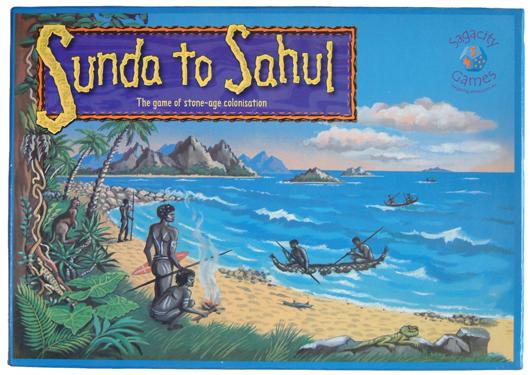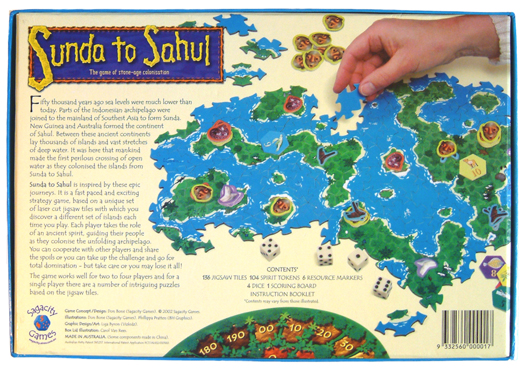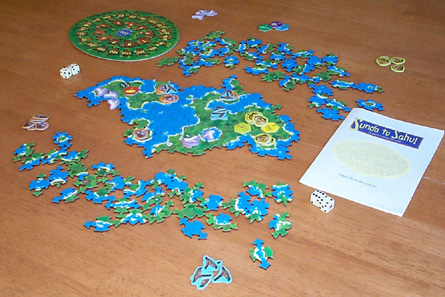Sunda to Sahul
| Jahr: | Essen 2003 |  |
| Autor/in: | Don Bone | |
| Verlag: | Sagacity Games | |
| Status: | Lieferbar | |
| Preis: | AUD 79.95 | |
| Kategorie: | Gesellschaftsspiel | |
| Anzahl Spieler: | 1-4 | |
| Altersgruppe: | ab 10 Jahre | |
| Spieldauer: | ¾ Stunde bis 2 Stunden | |
| Deutsche Rezensionen: | DLZ, H@LL9000, Spieletest, Spielphase | |
| Englische Rezensionen: | EFUN, The Games Journal | |
| FAQ: | FAQ (EN) | |
| Bezugsquellen: | EFUN (EN) | |
| Pressetext: | This game takes its inspiration from the migration of people down the Indonesian archipelago at least 50,000 years ago. The starting point for their epic journey was the mainland of Southeast Asia, which at that time was enlarged by lower sea levels. In archaeological circles this land mass is known as Sunda. The end of their journey was the joined land masses of Australia and New Guinea, known as Sahul. The game is based on a set of wooden jigsaw-like tiles. The image on each tile consists of some combination of land and sea. There are ten different tile shapes and each tile in the set has a unique combination of land/sea configuration and tile shape. Each player plays as one of four great spirits guiding their people to discover new land and claim it for their totem (clan). The game starts with all of the jigsaw tiles face up on the playing surface and one tile placed in a cleared space in the centre of the playing surface. Players select a tile from the pool of upturned tiles and try to join it to the placed tile(s) to extend the islands of the archipelago, 'discovering' a different set of islands each time they play the game. Each player starts with a number of tokens for their clan or totem. The main aim of the game is to claim land nodes points on the land of the islands where the corners of a number of tiles come together). The player who places the last tile at a land node may claim that node for their clan by adding one of their tokens to the island. If an island is completed, then all of the tokens on the island double in value. There is therefore an incentive for players who have tokens on an island to cooperate with each other to complete the island. But of course each is trying to get more out of the cooperation than the others. The game ends when one player has used all of their tokens or when no further tiles can be placed, or when the players agree to finish. The rules of the game are structured so that in its simplest form it can be learned in about 10 minutes. The game can be played either as a real-time race game or as a more traditional turns-based game. The race game takes about 30-45 minutes to play, while the turns-based game takes up to 90 minutes to play. There are a number of optional game elements that can be added once players are comfortable with the basic game: fresh-water rights (for water surrounded by land); tribes (clan tokens in a tribe are worth more than on their own); challenges (where a player can try to convert a token to their clan), and resources (owned by the player with the most tokens on the island at the end of the game). Some of these game elements result in more cooperation, while some result in more conflict. Players can mix and match the game elements to produce a game that suits their mood or style of play. The 'turns' version of the game involves a greater depth of strategic play, while the real time version of the game is a fast paced race demanding good visual pattern matching skills and an ability to negotiate coalitions with other players on the fly. Points are awarded at the end of the game for each player's placed tokens, for fresh-water rights and for resources. The value of a placed token depends on whether the island it is on is complete and on the number of tokens in its tribe. When you can't find someone to play the game with you, the jigsaw like tiles can be used to solve a number of intriguing puzzles. These range from simple, jigsaw like puzzles where a picture of an island is shown but the pieces that make it up are concealed, to the 'big-island challenge' where the object is to use the tiles to make a single island with no extraneous land and with as many land and freshwater nodes as possible. The most difficult challenge is to use all of the tiles in the set to make a set of islands where all of the tiles are used and all of the islands are complete. | |
| Material: | 136 Spielplanteile 104 Spielsteine 6 Rohstoffmarker 4 Würfel 1 Zähltafel | |
 | ||
 | ||
| Letzte Änderung: | 07.12.23 | |
| Link zu dieser Seite: | https://www.luding.org/cgi-bin/GameData.py/DEgameid/14470 | |
